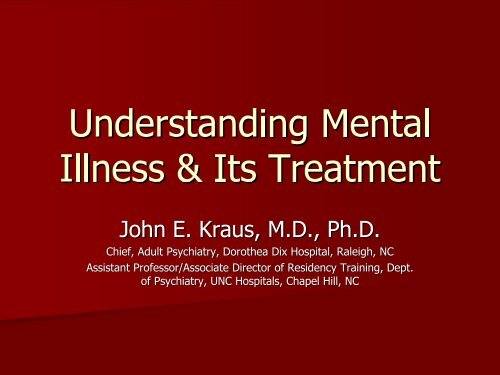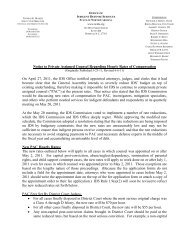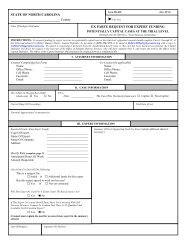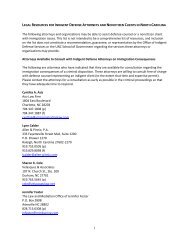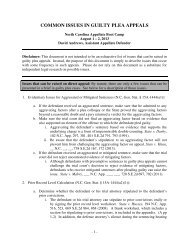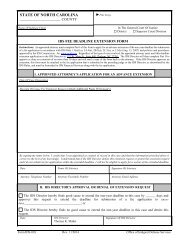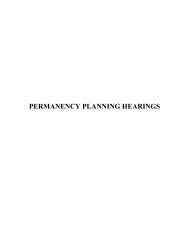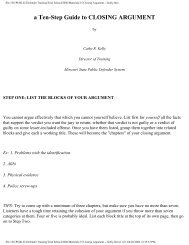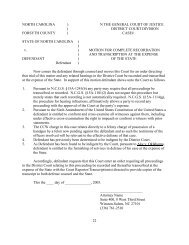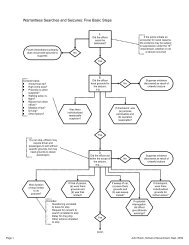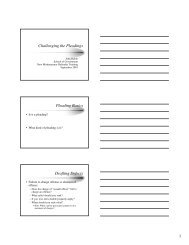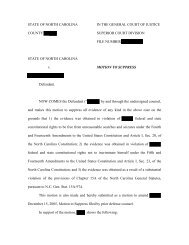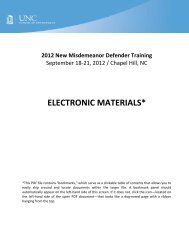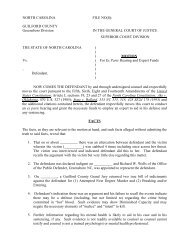John E. Kraus, M.D., Ph.D.
John E. Kraus, M.D., Ph.D.
John E. Kraus, M.D., Ph.D.
- No tags were found...
Create successful ePaper yourself
Turn your PDF publications into a flip-book with our unique Google optimized e-Paper software.
<strong>John</strong> E. <strong>Kraus</strong>, M.D., <strong>Ph</strong>.D.Chief, Adult Psychiatry, Dorothea Dix Hospital, Raleigh, NCAssistant Professor/Associate Director of Residency Training, Dept.of Psychiatry, UNC Hospitals, Chapel Hill, NC
What is mental illness andwhat are psychiatrists?
Mental Illness A disease of the brain Diseases of the brain are similar to othermedical illnesses where an important bodyorgan system is not working properly or atfull capacity– Congestive heart failure– Liver failure– Kidney failure
Mental Illness The human brain is the most complexorgan on the planet Understanding the biology of an organhelps us appreciate how diseases arisefrom its dysfunction The study of brain biology is known asneurobiology or neuroscience
Mental Illness Imagine everything a brain does, and thenimagine what might happen if even a tinything went wrong– Senses– Memory– Social cognition/judgment– Emotion– Planning/organization– Reality testing/logic
The Brain A transducer and communication device– Exterior interior– Interior interior– Interior exterior– Fromto small
Psychiatric Symptoms The vast majority of psychiatric symptomsarise from– Misinterpretation of environmental stimuli Misinterpretation of sensory information Misinterpretation of cognitive or social cues Delusions, ideas of reference– Internal representation in the absence ofenvironmental stimuli Hallucinations Affective symptoms
Psychiatric Symptoms Faulty transducer/transmitter Such symptoms result from abnormal oratypical brain activity– Impaired micro-communicationcommunication– Impaired macro-communicationcommunication– Impaired large-scale communication– Combinations of all of the above
From the Tradition of Kraepelin DSM– Diagnostic and Statistical Manual of MentalDisorders– Now in its 4 th Edition (with recent textrevision)– Developed from clinical research and fieldvalidation– To improve communication andunderstanding
Several Broad Categories Affective disorders Anxiety disorders Psychotic disorders Personality disorders Dementias Substance use disorders
Anxiety Disorders Include: specific phobia, social phobia,posttraumatic stress disorder, panicdisorder, and generalized anxiety disorder Characterized by persistent anxiety plusseveral other features depending upondiagnosis Anxiety: imagine fear response (physicaland psychological) but no external threat
Affective Disorders Depression: sad mood, hopelessness,anhedonia, , guilt, crying spells, sleep &appetite changes, and suicidal ideation Mania: distractibility, irritability,grandiosity, flight of ideas, decreasedsleep, impulsivity, poor judgment Each of these may or may not havepsychotic features
Psychosis A symptom, not a disease Can be associated with many disorders, bothpsychiatric and medical Gross impairment in reality testing Decreased ability to evaluate the accuracy ofperceptions and thoughts; make incorrectinferences about external reality (even in theface of contrary evidence)
Psychosis: Positive Symptoms Hallucinations: false perceptions in the absenceof real sensory stimuli Illusions: misperceptions of real external stimuli Delusion: a fixed false belief that the believermaintains even in the face of considerableevidence or likelihood to the contrary Ideas of Reference: the patient believes thatevents that are of no obvious reference to himrefer personally to him
Psychosis: Thought Disorder Loose associations: thought production inwhich there is no recognizable relationshipbetween ideas. Thoughts appear unconnected, or, at best,obliquely related to one another. Also: tangentiality, circumstantiality, , clangassociations, echolalia, perseveration.
Negative Symptoms:Andreasen’s A’s Affective flattening - unchanging facial expression;unchanging facial expression; expressive gestures, poor eye contact, affective nonresponsivity,inappropriate affect, lack of vocal inflections Alogia- poverty of speech/content of speech Avolition-apathy- grooming/hygiene,work/school, anergiagrooming/hygiene, impersistence at Anhedonia-asocialityasociality - interests/activities,interests/activities, interest insex/intamacyintamacy/closeness, few friends Attention deficits - social/testing inattentiveness
Psychotic Disorders Schizophrenia: combinations of thepsychotic symptoms discussed above Schizophreniform disorder Schizoaffective disorder: an illness likeschizophrenia occurring with an illness likedepression or bipolar disorder Delusional disorder: fixed false belief, non-bizarre, without other psychotic symptoms Substance-induced psychosis Psychotic Disorder NOS
Personality Disorders: Borderline Borderline personality disorder:impulsivity, affective instability, “black andwhite thinking,” splitting, fear ofabandonment, unstable relationships,chronic suicidal ideation, poor self-identity,self-injurious behavior (cutting), chronicsuicidal ideation Often, clinically exhausting
Personality Disorders: Antisocial Antisocial personality disorder: disregardfor the rights of others, lack of empathy,disregard for rules and regulations,impulsivity, difficulty learning fromexperience, substance abuse, frequentexposure to the criminal justice system,substance abuse, risk-taking behavior,problem with violence and aggression
Dementia Significant memory impairment– Short-term term earlier than long-term Other cognitive impairments– Word-finding difficulties– Peseveration– Constructional difficulties– Procedural difficulties Alzheimer’s, vascular, Pick’s
Substance Use Disorders Substance dependence– Increased tolerance– <strong>Ph</strong>ysiological withdrawal– Significant impairment in social function– Concomitant problems with impulsivity,aggression, illegal activities, mood andpsychotic problems Alcohol, cocaine, benzodiazepines,amphetamine, cannabis, etc.
Mental Illness There are several mental illnesses, whichare defined by specific symptom clustersas delineated by DSM-IVIV-TR Diagnoses aid in communication,assessing prognosis, determining durationof illness, and counseling regardinggenetic transmission Symptoms help guide pharmacologicaltreatment
<strong>Ph</strong>armacological Treatmentof Mental Illness
Function of the Brain In general, psychiatric drugs work directly ataltering micro-communicationcommunication However, over time, such alterations in micro-communication affect macro-communicationcommunication(neuronal networks) Finally, it is hoped that these latter changes willalter large-scale, or interpersonal,communication, as well as enhancing accurateinterpretation of environmental stimuli
<strong>Ph</strong>armacological Treatment Usually symptom driven what symptomsis the patient experiencing and how canwe help them? A single drug can target more than onesymptom
Antidepressants Are used to treat symptoms of depressionand anxiety Sometimes used to treat symptoms ofimpulsivity (SSRI selective serotoninreuptake inhibitors) Sometimes used to treat attention deficithyperactivity disorder (ADHD; buproprionor Wellbutrin ® )
SSRIs:Antidepressants– Fluoxetine = Prozac ®– Paroxetine = Paxil ®– Sertraline = Zoloft ®– Citalopram = Celexa ®– Fluvoxamine = Luvox ® Others: buproprion (Wellbutrin® ),mirtazapine (Remeron® ), nefazodone(Serzone® )
Anxiolytics Used to treat anxiety symptoms (mostoften antidepressants are used) Benzodiazepines– Acutely treat anxiety– Diazepam (Valium ® ), lorazepam (Ativan® )– Problems with abuse, dependence, andwithdrawal
Mood Stabilizers Help treat aspects of bipolar disorder(mania and depression) Sometimes used for impulsivity andaggression Sometimes used in refractoryschizophrenia
Mood Stabilizers Lithium, divalproex sodium (Depakote(® ),carbamazepine (Tegretol® ), lamotrigine(Lamictal® ), topiramate (Topamax® ) Also atypical antipsychotics, , particularlyolanzapine (Zyprexa® )
Antipsychotics Used to treat various symptoms ofpsychosis Most effective for positive symptoms Newer drugs are probably more effectivethan older drugs for negative andcognitive symptoms Sometimes used to treat aggression andimpulsivity; used to augmentantidepressants
Antipsychotics Older drugs: haloperidol (Haldol® ),chlorpromazine (Thorazine(® ) Newer drugs: clozapine (Clozaril® ),risperidone (Risperdal® ), olanzapine(Zyprexa® ), quetiapine (Seroquel® ),ziprasidone (Geodon® ), aripiprazole(Abilify® )
Long-lasting agents Intramuscular injections with sustainedrelease of medication Haloperidol decanoate, fluphenazinedecanoate (Prolixin® ) Newer drugs are attempting to createsimilar formulations
Treatment of Mental Illness Virtually all diseases are chronic andrequire long-term treatment Cessation of medication often results inrecurrence of illness Even patients complying with treatmentcan have recurrence of illness Lack of insight is often part of illness,particularly with schizophrenia
Treatment of Mental Illness For the majority of patients, treatmentresults in significant symptom relief Treatment of mental illness has similarsuccess rate to treatment of medicalillness A variety of modalities are employed inaddition to medications, thoughmedications are crucial
Dangerousness Direct: suicide / homicide / aggression Indirect: poor self care (sleep, eating,hygiene) and failure to care for medicalillnesses Indirect: cognitive (lack of organizationalskills, unable to perform activities of dailyliving All the above result from the signs andsymptoms of mental illness
Summary Mental illnesses are common braindiseases Diagnosis is based on clusters ofpresenting symptoms Treatment is target toward relievingsymptoms Persistent symptoms can lead todangerousness, necessitatinghospitalization
Common (and Uncommon)Abbreviations AEB = as evidenced by APD = antisocial personality disorder BPAD = bipolar affective disorder BPD = borderline personality disorder CPS = chronic paranoid schizophrenia
Common (and Uncommon)Abbreviations ED = emergency department GAD = generalized anxiety disorder HI = homicidal ideation MDD = major depressive disorder MI = mental illness
Common (and Uncommon)Abbreviations MR/DD = mental retardation/developmental disability NOS = not otherwise specified OCD = obsessive-compulsive disorder OD = overdose OSH = outside hospital prn = “as needed” PTA = prior to admission
Common (and Uncommon)Abbreviations PTSD = posttraumatic stress disorder SI = suicidal ideation SIB = self-injurious behavior SPMI = severely persistently mentally ill


